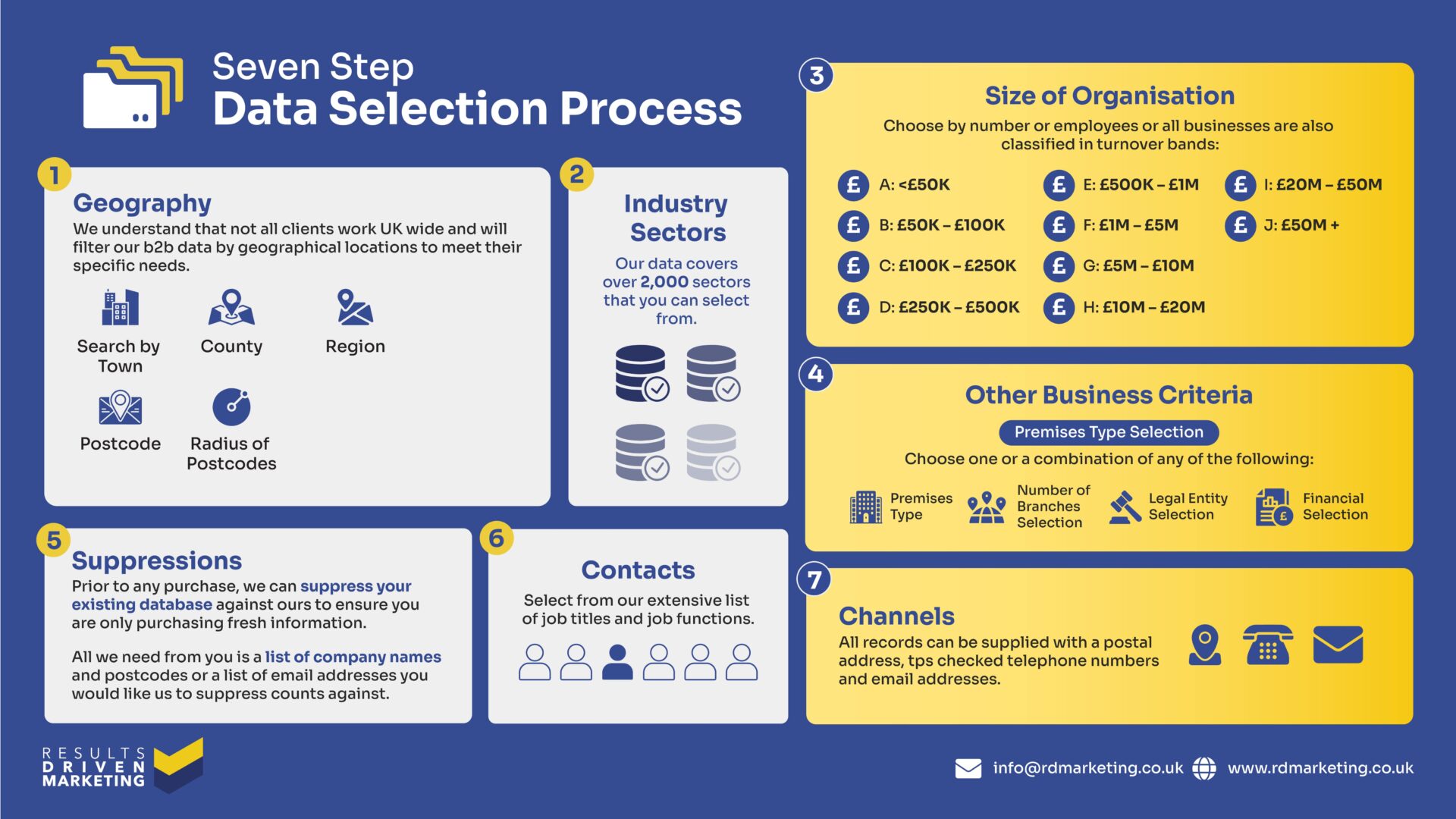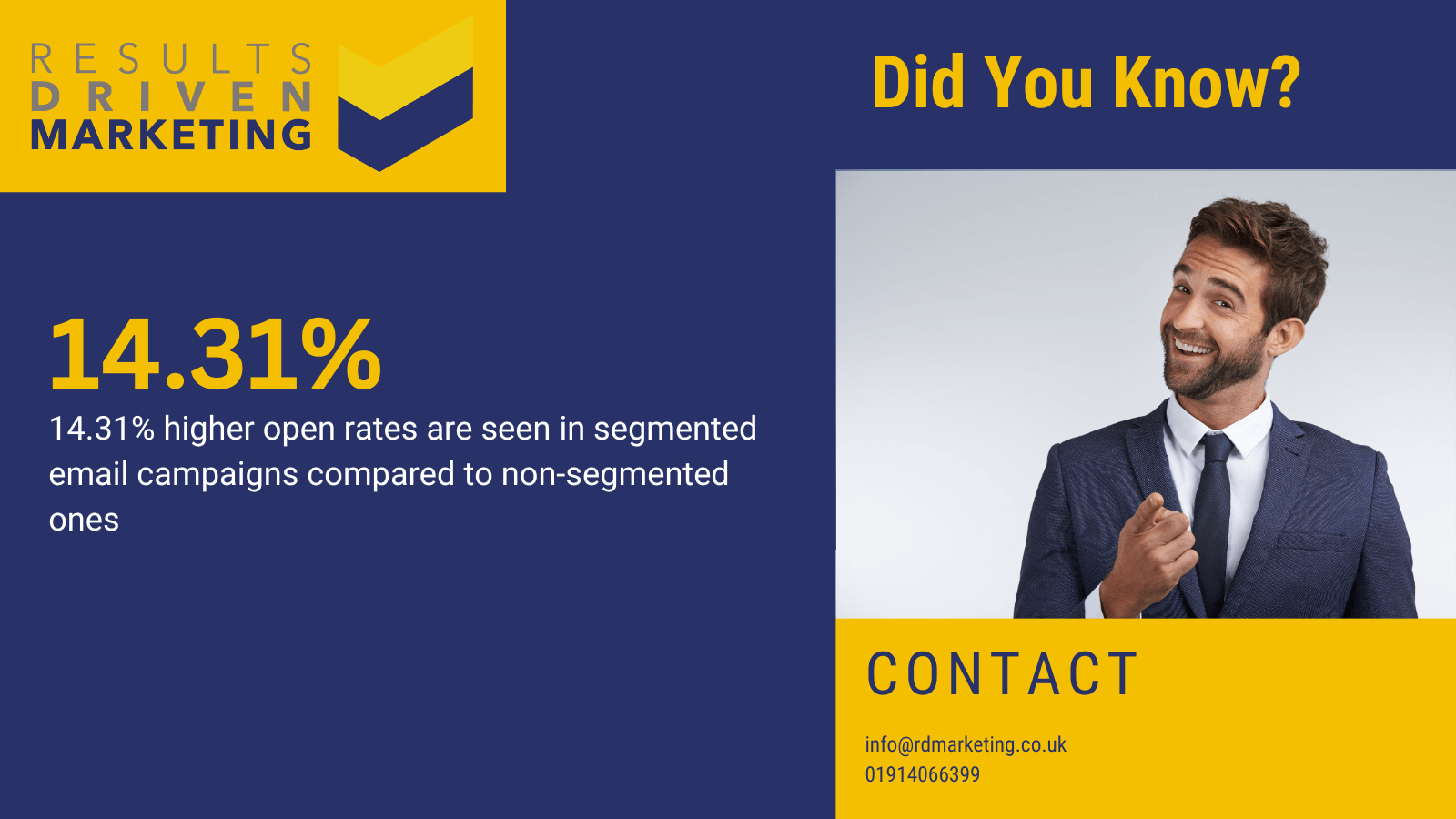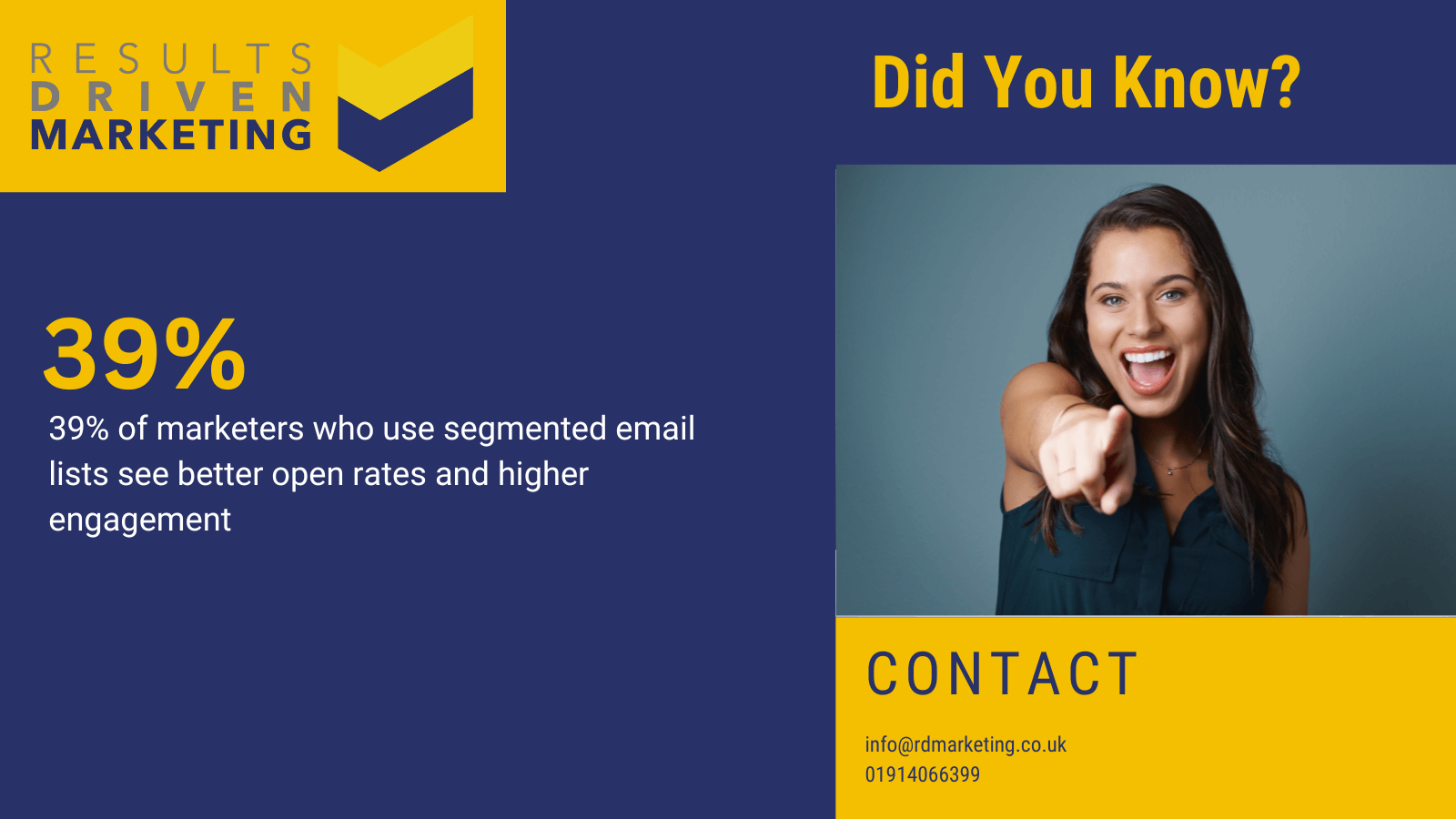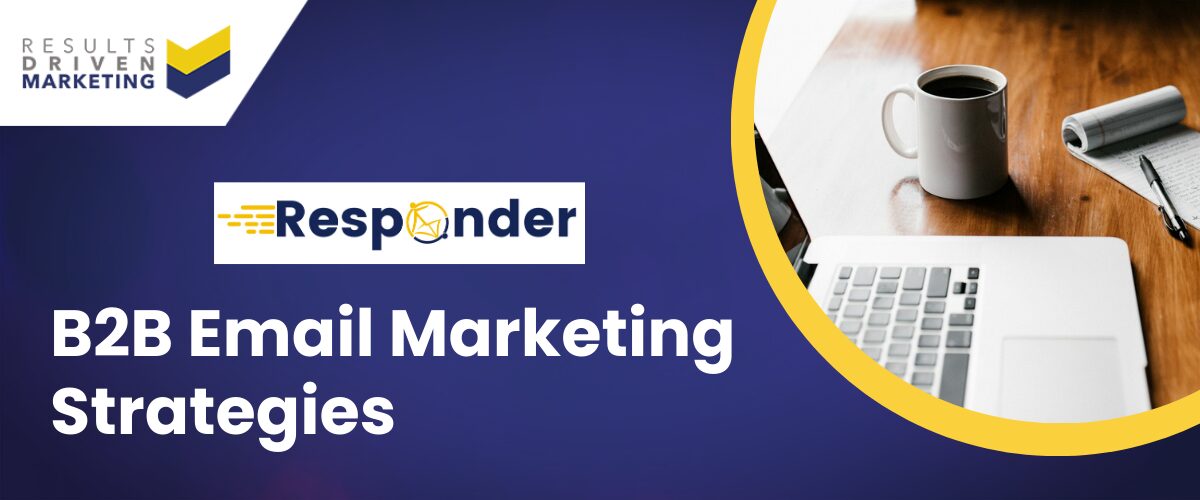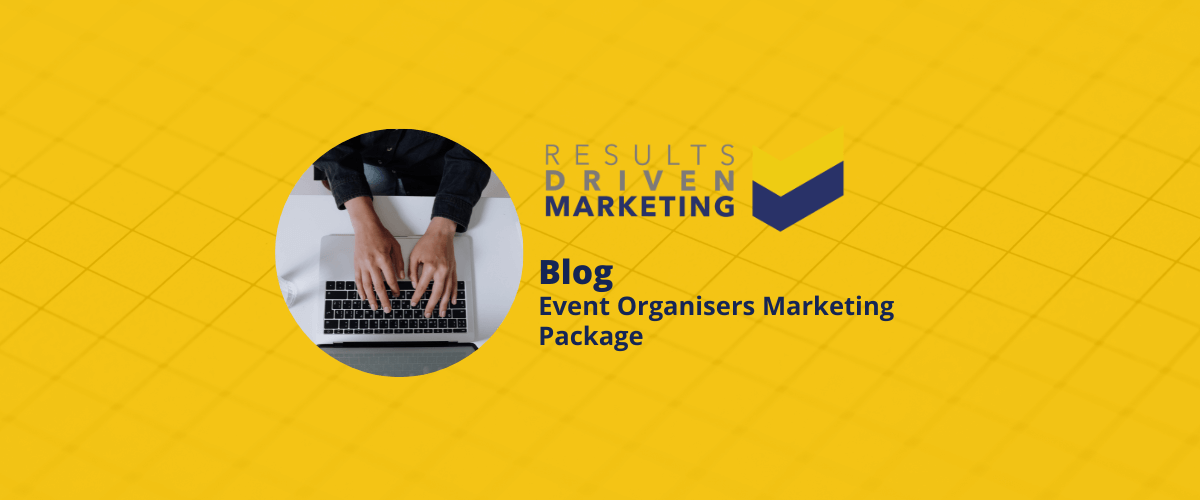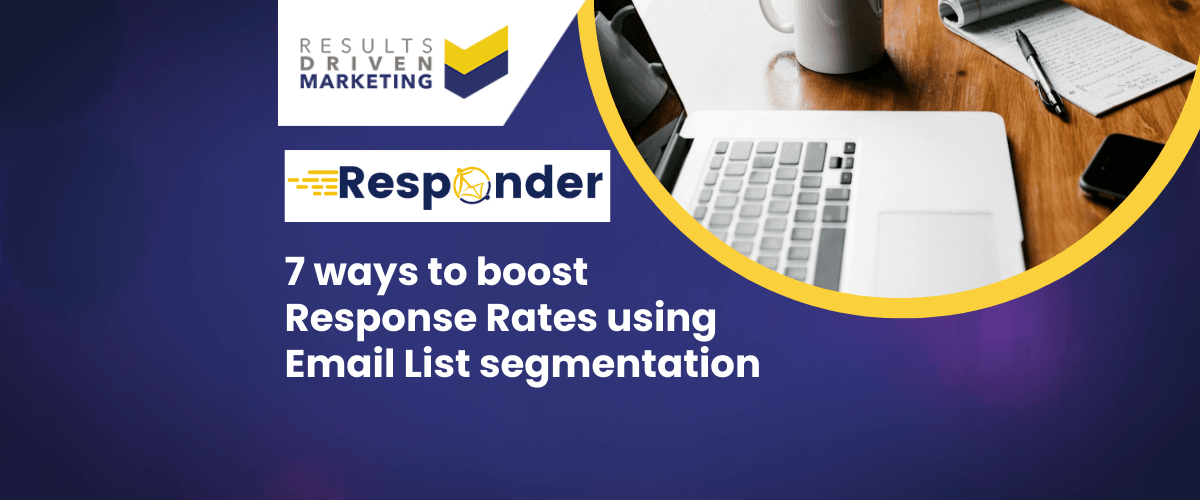
7 ways to boost Response Rates using Email List segmentation
When it comes to email marketing, email list segmentation is often overlooked, even though it’s key to a successful campaign. Many businesses focus on crafting the perfect message, but no matter how great your content is, it won’t deliver results if it’s sent to the wrong audience.
By breaking your email list into specific segments, you can send personalised, targeted messages that truly resonate with each group. Let’s dive deeper into what email list segmentation is and why it’s essential for boosting response rates in your campaigns.
Definition of Email List Segmentation
At its core, email list segmentation is simply the process of dividing your email subscribers into smaller, more specific groups based on various criteria. These criteria could range from demographic information, such as age or location, to behavioural data, like purchase history or email engagement. By segmenting your email list, you can tailor your content, ensuring the right message reaches the right people at the right time.
Segmentation can be as basic or as detailed as you want. Some common ways to segment include:
- Demographics (age, gender, occupation, etc.)
- Purchase behaviour (recent buyers, frequent shoppers, high spenders)
- Email engagement (open rates, click-through rates)
- Location or time zone
For example, you wouldn’t want to send the same email promoting your UK-focused direct mail data services to an audience in Asia, right? Instead, you could segment that audience and tailor an email promoting your international email list services instead, ensuring it speaks directly to their needs.
Table of contents:
Personalise by Demographics
One of the most straightforward yet incredibly effective ways to segment your email list is by using demographics. It’s a method that helps you get down to the core of who your audience is and what they want. When you know basic demographic details like age, gender, and location, you can tailor your messaging in ways that feel a lot more personal and relevant. This kind of personalised touch makes a big difference when it comes to grabbing attention and boosting response rates.
Let’s break this down into some key demographic factors and how email list segmentation can work for each:
Age
Age is one of the most important demographic factors to consider in email list segmentation. People from different age groups often have vastly different preferences, communication styles, and purchasing behaviours. Think about it: a 20-year-old may respond well to more playful, energetic copy, while someone in their 50s may appreciate a more professional and informative tone.
By segmenting your email list based on age, you can deliver emails that resonate with specific age brackets, making your message feel more personal. For example, promoting products or services for younger audiences might include pop-culture references or a casual tone, while emails targeting older generations might focus on trust and experience.
If you’re promoting services like B2B data, adjusting your message to appeal to a younger, tech-savvy audience versus a more traditional business owner could make all the difference in driving engagement and response.
Gender
Gender can also play a big role in email list segmentation. Men and women may respond differently to certain types of messaging, offers, or even the design and layout of your emails. While it’s important not to overgeneralise, you can still use gender-based insights to fine-tune your approach.
For instance, if you’re marketing something like telemarketing data, you could create different email versions that highlight the benefits of your service in ways that appeal specifically to men or women. The key is subtlety—adjusting language, imagery, and calls to action (CTAs) to make your emails feel like they were written just for them.
Location
Location-based segmentation is another highly effective approach. Where your subscribers live can have a major impact on what they care about, how they consume content, and when they’re most likely to engage with emails.
By segmenting your email list by location, you can ensure your emails are timely, relevant, and tailored to geographic preferences. For instance, if you’re promoting a direct mail data service, you could create location-specific campaigns that highlight how your product can be tailored for local markets.
Not only that, but knowing where your subscribers are located also helps you respect time zones. You wouldn’t want to send an email promoting your international email list services to someone at 3 a.m. in their time zone, right? Location-based segmentation allows you to send emails at optimal times, increasing the chances they’ll open and engage with your content.
Other Demographic Factors
While age, gender, and location are some of the more common demographics to consider, don’t forget about other details like occupation, income level, or even relationship status. Each of these factors can help you further fine-tune your email campaigns.
For example, if you’re offering consumer data, knowing your audience’s occupation or income level can help you craft messaging that appeals to their professional or financial situation. It’s all about making your emails feel more relevant and, therefore, more likely to drive engagement.
By using email list segmentation based on demographics, you’re able to craft highly personalised messages that resonate with specific groups of people. This level of personalisation can significantly boost response rates, as your audience feels like your emails are speaking directly to them.
Want to get started? Our email address list data services can help you easily gather the demographic information you need to create more effective, personalised campaigns. You can explore our data solutions here.
When you combine demographic segmentation with data cleaning tools like our CTPS checker and data cleansing services, your email campaigns will not only be more targeted but also more accurate and compliant with regulations.
In the next section, we’ll look at how segmenting your email list based on purchase history and behaviour can take your email marketing game to the next level.
Segment by Purchase History and behaviour
Segmenting your email list based on purchase history and user behaviour is one of the most powerful ways to deliver hyper-relevant content. When you know what products or services a subscriber has already shown interest in—or even better, what they’ve purchased—you can send tailored offers that feel more like helpful recommendations rather than generic marketing.
This type of email list segmentation taps directly into the customer’s existing relationship with your brand, which is why it’s so effective at boosting response rates.
How Tracking User behaviour Helps Tailor Content
Understanding how a customer interacts with your website, what products they’ve browsed, and what they’ve bought gives you valuable insight into their preferences. By segmenting your email list based on these behaviours, you can follow up with content that speaks directly to their interests.
For example:
- If someone has purchased a product from you before, you can segment them into a “past buyers” group. This allows you to send personalised follow-up emails suggesting complementary products, rather than sending out random promotions that don’t align with their previous purchases.
- Users who have browsed certain product categories but haven’t made a purchase can be placed into a “browsers” segment. You can then target them with emails showcasing related products or offering discounts to encourage them to take the next step.
Tracking behaviour doesn’t stop with just purchases. It can include how they interact with your emails. Have they opened your last few emails but not clicked through? Or maybe they clicked a link but didn’t complete a purchase. All of these touchpoints offer insight into what kind of follow-up messaging might resonate with them.
For businesses offering B2B data solutions, like ours, segmentation based on previous purchases or interest in specific types of data (such as consumer data or telemarketing data) allows you to send highly relevant content that speaks to each client’s specific needs.
The Benefits of Sending Targeted Offers Based on Previous Interactions
The more relevant the email, the better the engagement. That’s why segmenting by purchase history and user behaviour works so well. When you send an offer or content that’s based on what someone has already shown interest in, they’re much more likely to open, click, and ultimately convert.
Here are a few ways this type of email list segmentation can benefit your campaigns:
Increase Open Rates: When customers receive emails related to products they’ve already purchased or shown interest in, they’re more likely to find that email relevant and worth opening.
Boost Click-Through Rates: If the content in the email matches their interests, such as suggesting additional products that complement a recent purchase, recipients are far more likely to click through and explore more.
Drive Repeat Business: Segmenting your email list by purchase history allows you to send offers that cater to loyal customers. You can offer exclusive discounts to frequent buyers, or send early access to new products, keeping them engaged with your brand.
Recover Lost Sales: For customers who abandoned their cart or browsed but didn’t buy, a well-timed, targeted follow-up email can nudge them towards completing their purchase. Sometimes, all it takes is a reminder or a limited-time discount to bring them back.
Imagine offering an upsell to clients who have already purchased your direct mail data service by sending a personalised email about your email marketing management services. You’re speaking to a need they’ve already demonstrated, making it easier to convert them again.
As well as…..
Tracking behaviour also helps in data enrichment—ensuring the information in your email list is always up to date and accurate. Our data enrichment services can help you keep your customer profiles sharp, so you’re always working with the most relevant insights.
Another key benefit of this type of segmentation is that it naturally reduces churn. Sending irrelevant emails is a fast way to lose subscribers, but delivering personalised content keeps your audience engaged, satisfied, and more likely to continue doing business with you.
Need help getting your email list organised? Our email address list data service can provide you with the necessary tools to manage and segment your audience effectively. Explore it here.
With behaviour-based email list segmentation, you’ll not only see higher engagement but also cultivate stronger relationships with your customers. The more relevant your message, the more valuable your audience will perceive your emails to be—and the more likely they are to respond.
In the next section, we’ll talk about how you can leverage email engagement history to further improve your segmentation and target customers who are most likely to interact with your content.
Leverage Email Engagement History
Segmenting your email list based on how subscribers engage with your emails is another fantastic way to improve response rates. By tracking email engagement history—such as open rates, click-throughs, and overall interaction levels—you can create segments that allow you to target active subscribers more effectively, while also re-engaging those who have become inactive.
This type of email list segmentation ensures that you’re reaching your audience with the right message at the right time.
Using Open Rates, Click-Throughs, and Engagement Levels to Segment Audiences
One of the easiest and most effective ways to leverage email list segmentation is by using your subscribers’ engagement levels. Essentially, this means categorising your audience based on how often they open your emails, how frequently they click through to your website, or whether they interact with your content at all.
For example:
- Highly engaged subscribers: These are the people who open your emails regularly and click on the links inside. You can segment them into a “highly engaged” group and send them more frequent updates, product launches, or even exclusive offers.
- Moderately engaged subscribers: These are individuals who occasionally open your emails and may click on links sporadically. For this group, you might want to send more targeted emails that re-spark their interest, perhaps focusing on discounts or special deals.
- Low engagement or inactive subscribers: These are the people who rarely open your emails or have stopped interacting altogether. By identifying this segment, you can send targeted re-engagement emails or special win-back campaigns to encourage them to become active again.
This approach is perfect when promoting services like telemarketing data. By targeting highly engaged subscribers with case studies showing the benefits of telemarketing, or sending a more personal email to moderately engaged users, you increase the likelihood of driving them further down the sales funnel.
Tracking engagement helps you identify which of your subscribers are interested in what you’re sending out. This not only boosts the chances of a response but also keeps your email list healthy by ensuring you’re focusing on the most engaged recipients.
How to Re-Engage Inactive Subscribers with Tailored Messages
Inactive subscribers aren’t necessarily a lost cause. Many times, people lose interest in your emails simply because they’re receiving content that doesn’t feel relevant to them anymore. Fortunately, using email list segmentation based on engagement data allows you to craft re-engagement campaigns that specifically target these inactive users.
Here’s how to re-engage them effectively:
Send a Re-Engagement Campaign: Start by segmenting out your inactive subscribers—people who haven’t opened an email in, say, the last 3 to 6 months. Then, craft a personalised email that directly addresses their inactivity. Something simple like, “We’ve missed you!” or “Still interested in [your product/service]?” can grab attention. Offering a small incentive, such as a discount, can also help nudge them to take action.
Offer Value: For these subscribers, it’s important to showcase why your emails are worth their time. Highlight any new products, updates, or services they might have missed out on. If you sell international email list services, for example, mention how your latest offering can benefit businesses expanding into new markets.
Use a Poll or Survey: Sometimes, people become inactive because your emails aren’t hitting the mark. Ask for feedback! Send a short survey or poll asking what type of content they’d prefer to receive. This shows you value their opinion and gives you insights to improve future segmentation and messaging.
Send a Final Notice Email: For those who remain unengaged, a “final notice” email is a great way to prompt action. Something like, “We’d hate to see you go, but this could be the last email you receive from us.” This urgency often sparks a response from people who may have simply been overlooking your emails.
As well as…..
Our email marketing management services make it easy to set up automated workflows for re-engagement campaigns, allowing you to reach out to these subscribers effortlessly.
By putting your efforts into re-engaging inactive subscribers, you not only clean up your list but also breathe life back into relationships that may have been going stale. And don’t forget, it’s more cost-effective to win back an inactive subscriber than to acquire a new one.
Incorporating email list segmentation based on engagement levels ensures that your content remains relevant to each group of subscribers. Those who are actively engaging with your emails can be rewarded with more exclusive content, while those who are inactive can be nudged back into action with the right re-engagement strategy.
Want to refine your audience even further? Our data cleansing services can help ensure that your list remains accurate and up-to-date, eliminating any dead weight and optimising your campaigns for success. Learn more about them here.
By focusing on how your subscribers interact with your emails, you can craft better-targeted messages that align with their level of interest, ultimately leading to higher response rates, fewer unsubscribes, and a healthier, more engaged email list.
Next, we’ll explore how time-based segmentation can add another layer of precision to your email campaigns, helping you deliver the right message at exactly the right moment. Stay tuned!
Time-Based Segmentation
When it comes to email list segmentation, timing can be everything. Sending the right email to the right audience at the right time can make a huge difference in how well your campaigns perform. That’s where time-based segmentation comes in. Whether it’s optimising delivery times based on subscriber habits or using specific event triggers tied to customer actions, timing your emails correctly can significantly increase your open rates, engagement, and overall conversions.
Sending Emails Based on the Optimal Times for Specific Segments
Not all subscribers check their emails at the same time of day. Some might be early risers who catch up on their inbox in the morning, while others may be night owls who only open emails after work. By using email list segmentation to understand when specific segments of your audience are most active, you can optimise your send times for maximum engagement.
Here’s how you can approach time-based segmentation:
- Analyse Historical Data: Look at when your subscribers tend to open and engage with your emails. Are there patterns? Maybe your B2B data clients tend to open emails in the early hours, while your consumer data subscribers are more active in the afternoons. By identifying these trends, you can schedule your email sends to coincide with your audience’s peak engagement times.
- Segment by Time Zone: If your email list spans multiple regions, it’s essential to consider time zones. For example, if you’re promoting direct mail data to a UK audience, you wouldn’t want to send your emails at 3 a.m. local time. By segmenting your list based on location, you can schedule emails to arrive when your audience is most likely to open them, no matter where they are.
As well as…..
- Test and Optimise: Time-based segmentation isn’t a one-size-fits-all solution. What works for one segment may not work for another. Run A/B tests on different send times to see when each segment of your audience is most responsive. For instance, your international email list subscribers might react better to emails sent early in the week, while your telemarketing data customers might engage more on weekends.
By using time-based segmentation, you ensure that your emails land in your subscribers’ inboxes at a time when they’re most likely to engage, increasing your open and click-through rates. Tools like our email marketing management services can help automate and optimise this process, so you don’t have to manually adjust send times for different segments.
How to Segment Lists Based on the Customer Lifecycle or Event Triggers
Another powerful aspect of time-based email list segmentation is targeting subscribers based on their position in the customer lifecycle or triggering emails based on specific events. This approach allows you to deliver highly relevant emails at key moments, whether it’s right after a customer makes a purchase, abandons a cart, or reaches an anniversary with your business.
Here are a few ways to use lifecycle and event-based triggers in your segmentation:
Welcome Emails: When someone first signs up for your email list, it’s the perfect time to send a welcome email. This should be an automated, event-triggered email that introduces your brand and highlights the value you offer. If they’ve subscribed to hear more about B2B data solutions, for example, the email should provide insights into how your services can help them grow their business.
Post-Purchase Follow-ups: After a customer makes a purchase, use email list segmentation to send a follow-up email thanking them for their order and suggesting complementary products or services. If they’ve just bought direct mail data, follow up with a targeted email about your data enrichment services or email address list data offerings that can enhance their campaign efforts.
As well as…..
Abandoned Cart Reminders: If someone added items to their cart but didn’t complete the purchase, send an abandoned cart email a few hours or even a day later to remind them. Timing is crucial here—too soon might seem pushy, while too late could make them forget about the purchase altogether. By segmenting your list to trigger emails at just the right moment, you increase the chances of recovering that lost sale.
Milestone Emails: Segment your audience based on how long they’ve been with your brand. Sending anniversary or birthday emails can add a personal touch and make your subscribers feel valued. For instance, you can offer a special discount to long-time clients of your international email list services to celebrate their ongoing loyalty.
Re-Engagement Emails: For customers who have been inactive for a while, set up automated re-engagement campaigns to remind them of what they’re missing. Segment these customers based on their inactivity and use tailored messages to win them back. Highlight new features, products, or limited-time offers to rekindle their interest.
Use Geographic Segmentation
Geographic segmentation is one of the most effective ways to tailor your email marketing efforts to fit the unique needs of different regions. By using email list segmentation based on location, you can ensure that your emails resonate with your audience’s local culture, preferences, and time zones. This approach not only increases engagement but also boosts conversion rates by delivering relevant, timely content that speaks directly to your subscribers’ environment.
How to Create Geographically Targeted Campaigns
Geographic segmentation allows you to divide your email list based on subscribers’ physical locations, whether it’s by country, city, or even neighbourhood. This kind of email list segmentation is especially useful if you run campaigns that rely heavily on location-specific information, such as store openings, events, or regionally restricted promotions.
Here’s how you can craft geographically targeted campaigns:
Localise Your Content: Tailor the messaging and tone of your emails to reflect regional preferences. For instance, promoting B2B data services to businesses in London may require a different approach than reaching out to companies in rural parts of the UK. Subtle changes in language, images, and even the offers you highlight can make a big difference.
Regional Promotions: Segmenting by geography also allows you to create promotions that are only valid in certain areas. For example, if you’re promoting direct mail data, you might offer a discount to businesses in a specific city or region where demand is higher.
As well as…..
Customising Offers by Market: Different regions often have varying economic landscapes, market maturity, and customer needs. With geographic segmentation, you can customise offers based on local market conditions. If you’re marketing international email lists, your message to a subscriber in Germany might highlight different benefits than one targeted at an audience in the US or India.
Leverage Local Events and Holidays: Another way to use geographic segmentation effectively is by tying your emails to local events, holidays, or cultural moments. This creates a sense of relevance that increases engagement. For example, if you’re offering email marketing management services and know that a specific country is celebrating a major event, you can frame your messaging around it, making it feel timely and personal.
The Importance of Considering Time Zones, Local Events, and Regional Preferences
Time zones can make or break your email campaign. While your message might be well-crafted, sending it at the wrong time can lead to low open rates. When using email list segmentation based on geography, it’s crucial to adjust your send times according to local time zones. This ensures that your email hits inboxes when subscribers are most likely to check their emails.
Here are some things to keep in mind:
Time Zone Sensitivity: If you’re running a global campaign, segmenting by time zone ensures that your emails are sent at optimal times. For example, if you’re marketing to a UK audience with your telemarketing data, you should schedule the email to hit their inbox during the morning or early afternoon—when they are most likely to engage. The same message sent to subscribers in Australia would need to go out at a completely different time to ensure it’s not missed.
Local Preferences: Different regions may respond differently to certain types of content. Some cultures appreciate formality, while others prefer a more casual tone. Similarly, preferences for color schemes, imagery, and even subject lines can vary widely. By using email address list data segmented by location, you can fine-tune your approach to match regional tastes and expectations.
As well as…..
Adapt to Local Regulations: When emailing subscribers in different countries, it’s also important to be mindful of local regulations. Laws around data privacy, such as GDPR in Europe, dictate how you can use personal information in email marketing. This is where services like our CTPS checker become invaluable, ensuring that your campaigns comply with local regulations and are always on the right side of the law.
By taking the time to segment your audience geographically and making sure that each region receives content that speaks directly to their unique circumstances, you build stronger connections and increase the likelihood of engagement. Whether you’re promoting consumer data or data enrichment services, location-specific campaigns can yield better results simply because they feel more personalised.
Incorporating geographic segmentation into your email list segmentation strategy ensures that your emails are not only more relevant but also better timed, leading to higher open rates and improved customer satisfaction. By understanding the needs, preferences, and even local culture of your audience, you create campaigns that truly connect on a local level.
Looking to get started? Our data cleansing services can help ensure your email lists are accurate and primed for geographic segmentation. And if you need help targeting specific international markets, check out our international email list solutions to reach the right audience no matter where they are.
Tailor Messaging for Industry-Specific Segments (For B2B)
When it comes to B2B email marketing, one of the most effective strategies is to tailor your messaging to specific industries. No two sectors are exactly alike—each has its own challenges, priorities, and needs.
This is why email list segmentation by industry or job function is absolutely essential for B2B emails. By understanding and addressing the unique pain points of each industry, you can craft content that resonates deeply with your audience, driving engagement and boosting response rates.
Why It’s Essential to Segment by Industry or Job Function for B2B Emails
In the B2B world, generic, one-size-fits-all messaging simply doesn’t cut it. Decision-makers in different industries have vastly different goals, budgets, and operational hurdles. A CEO in the construction industry will have entirely different needs than an IT director in the healthcare sector. Segmenting your email list by industry or job function allows you to speak directly to those needs, increasing the chances of engagement.
Here’s why segmenting by industry or job role is critical for B2B:
- Relevance: By segmenting based on industry, you can deliver content that feels directly relevant to the recipient. For example, promoting telemarketing data to a retail business might highlight how telemarketing can help drive customer engagement, while the same service pitched to a logistics company would focus on improving supply chain communications.
- Positioning: Each industry faces its own set of challenges, and your messaging should reflect that. By using email list segmentation, you can position your product or service as a solution tailored specifically for the recipient’s industry. If you’re offering B2B data, segmenting by industry enables you to showcase how your data can solve problems that are unique to that sector.
As well as…..
- Job Role Sensitivity: Beyond industry segmentation, job function is another powerful layer to add. The pain points of a CFO will differ from those of a marketing director. By segmenting your emails based on job roles, you can adjust the messaging to highlight the specific benefits that matter most to each decision-maker. For instance, a finance executive might appreciate the cost-saving benefits of using direct mail data, while a marketing manager might be more interested in its ability to target niche audiences.
Segmenting by industry and job function isn’t just a best practice—it’s a necessity in today’s highly competitive B2B landscape. Want to reach specific industries with accurate data? Our B2B data services can help you get there. Check them out here.
Examples of Crafting Sector-Specific Content That Speaks to the Pain Points of Different Industries
The key to success with email list segmentation is to understand what keeps decision-makers up at night. Once you have that knowledge, you can craft emails that speak directly to those pain points. Here are a few examples of how to create industry-specific email content that drives results:
Construction Industry: Let’s say you’re marketing your email address list data service to construction companies. Instead of sending a generic email, segment your list and focus on the unique challenges of the construction industry—such as finding reliable suppliers or contractors. You could highlight how your email data service helps construction companies connect with vetted suppliers, improving their project timelines.
Healthcare Sector: When reaching out to healthcare organisations, compliance and data security are often top concerns. If you’re promoting data enrichment services, your emails should focus on how your service helps healthcare providers maintain accurate, up-to-date patient information while adhering to strict compliance regulations like HIPAA.
As well as…..
Retail Industry: For retail businesses, customer acquisition and retention are always priorities. If you’re promoting telemarketing data to retail companies, emphasise how telemarketing can help them reach new customers more effectively and boost loyalty with personalised, direct communication strategies.
Technology Sector: If you’re emailing a tech company about your international email list service, you might focus on how it helps tech firms expand into global markets, connecting them with key decision-makers in regions they’re trying to enter. The emphasis here would be on scalability and reaching international B2B clients.
Financial Services: Financial firms often seek data that can help them make more informed decisions. When offering B2B data to financial companies, focus on how your data can support market research, improve client targeting, and reduce risk in decision-making processes.
By personalising your emails to match the industry-specific concerns and challenges, you can build trust and establish your brand as a solution provider that truly understands their business. This approach, combined with effective email list segmentation, will naturally lead to better engagement rates and more conversions.
Need help cleaning up your industry-targeted lists? Our data cleansing services ensure your segmented lists are accurate and effective, allowing you to target the right industries with the right messages.
In the world of email marketing, email list segmentation is not just a nice-to-have—it’s an absolute must if you want to boost response rates and drive meaningful engagement.
By dividing your email list into more specific segments based on factors like demographics, behaviour, location, and industry, you can craft personalised and relevant messaging that resonates with each group. Segmentation helps you ensure that your emails land in the right inboxes, at the right time, with content that speaks directly to the recipient’s needs.
Summarising the Benefits of Segmentation for Boosting Response Rates
Let’s recap the key advantages of using email list segmentation in your email marketing strategy:
- Increased Relevance: By tailoring your emails to each segment’s unique needs, interests, or behaviours, your messages become far more relevant and impactful. Relevant emails are much more likely to be opened, read, and acted upon.
- Higher Engagement: Whether it’s optimising send times based on time zones, offering industry-specific solutions, or re-engaging inactive subscribers, segmented campaigns naturally drive better open and click-through rates.
- Personalised Experiences: Segmentation allows you to speak directly to your audience, creating a personalised experience that feels like it’s crafted just for them. This builds trust and strengthens relationships.
- Improved Conversions: Ultimately, the more targeted and relevant your emails are, the more likely your audience is to take action, whether that’s making a purchase, signing up for a webinar, or downloading a resource.
For example, using segmentation to target different industries with our B2B data services or creating localised offers for specific regions with our direct mail data can make your emails feel incredibly specific and useful to each recipient.
Final Tips for Getting Started with Email Segmentation
Ready to jump into email list segmentation but not sure where to start? Here are a few final tips:
Start Small: Don’t feel the need to create dozens of segments right away. Begin with basic criteria like demographics or engagement levels, then gradually add more layers like purchase behaviour or job function as you gather more data.
Use the Right Tools: Segmentation can get complex, but the right tools can simplify the process. Platforms like our email marketing management services offer automation features that help you segment your lists and send targeted campaigns with ease.
Keep Your Data Clean: Accurate data is the foundation of effective segmentation. Use our data cleansing services to ensure your email lists are up-to-date and free from errors, ensuring your segmented emails reach the right people.
Track and Optimise: Segmentation isn’t a set-it-and-forget-it strategy. Continuously monitor the performance of your segmented campaigns and adjust as needed. Over time, you’ll gain deeper insights into what works for each segment and can fine-tune your approach for even better results.
Personalise at Scale: Don’t underestimate the power of segmentation when combined with automation. You can create highly personalised campaigns that scale easily. For example, you can send personalised follow-ups based on a subscriber’s activity or customise offers using our consumer data or international email list services.
Call to Action: Try Our Email Marketing Platform for Easy and Effective Segmentation
Segmentation might sound complex, but with the right tools, it can be seamless and incredibly effective. Whether you’re looking to target specific industries with B2B data, enhance your messaging with data enrichment services, or ensure compliance with our CTPS checker, our platform is designed to make segmentation straightforward and impactful.
Ready to take your email marketing to the next level? Explore our email marketing management services today and see how easy it can be to segment your lists, personalise your campaigns, and drive results that matter.
If you’re looking for a competitive edge in email marketing, email list segmentation is the way to go. Let us help you get started with the right data, the best tools, and expert advice to boost your ROI and grow your business.
Visit www.rdmarketing.co.uk to learn more!
Who are we?
Thinking about “how do I buy data“?
Providing b2b database solutions is our passion.
Offering a consultancy service prior to purchase, our advisors always aim to supply a database that meets your specific marketing needs, exactly.
We also supply email marketing solutions with our email marketing platform and email automation software.
Results Driven Marketing have the best data of email lists for your networking solutions as well as direct mailing lists & telemarketing data in telemarketing lists
We provide data cleansing and data enrichment services to make sure you get the best data quality.
We provide email marketing lists and an international email list for your business needs.
At RDM We provide b2c data as we have connections with the best b2c data brokers.
A good quality b2b database is the heartbeat of any direct marketing campaign…
It makes sense to ensure you have access to the best!
Call us today on 0191 406 6399 to discuss your specific needs.
Results Driven Marketing
0191 406 6399


